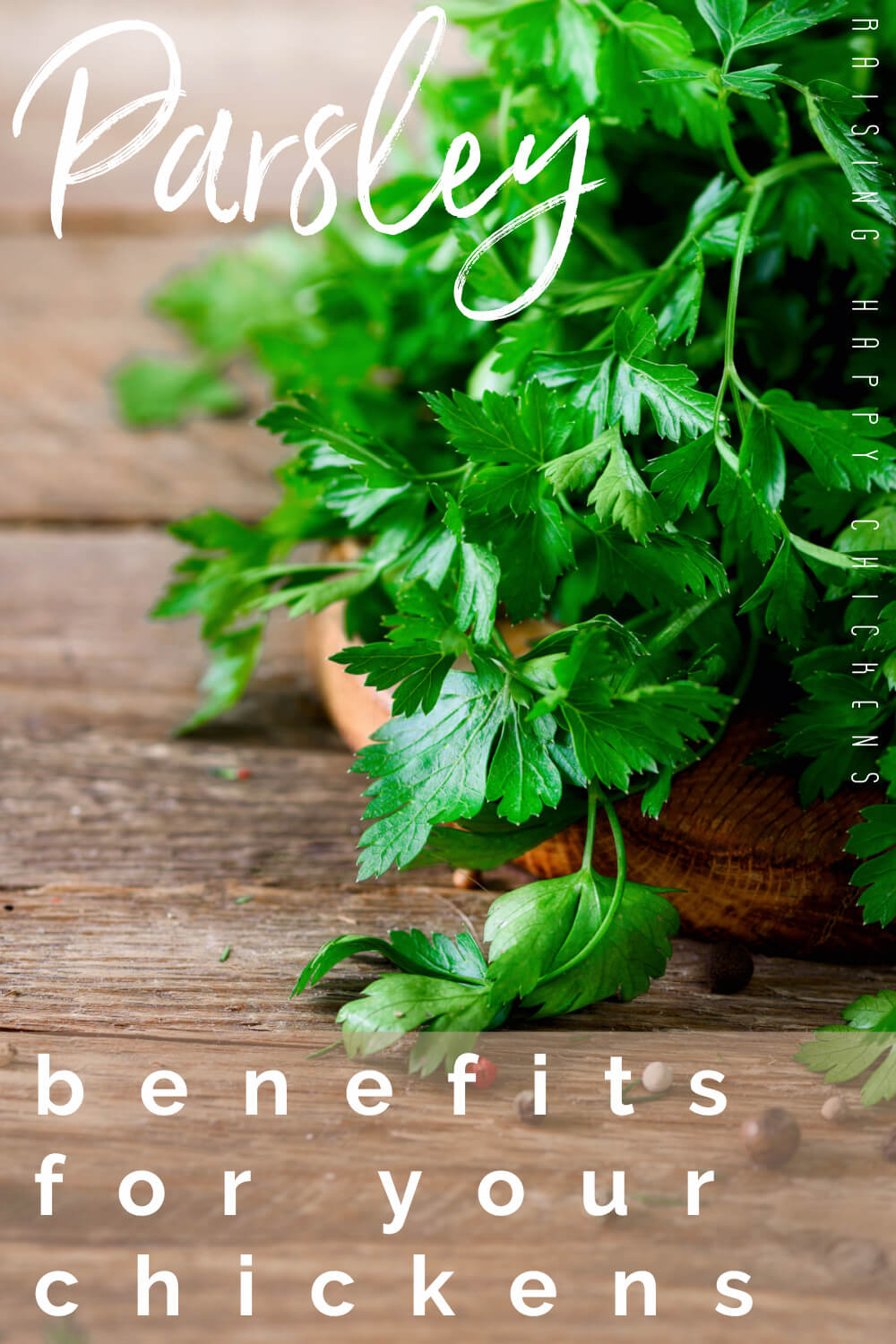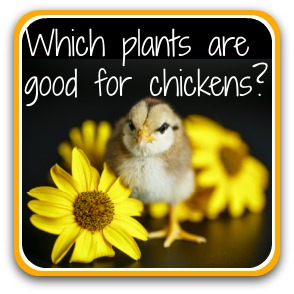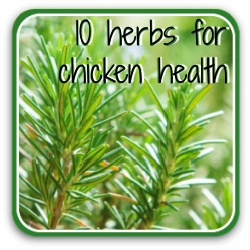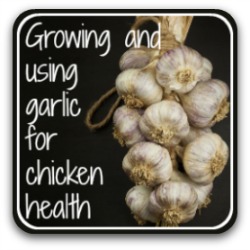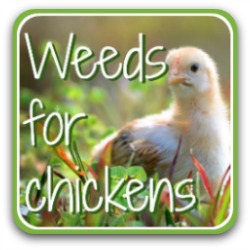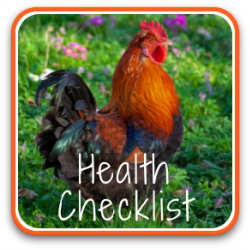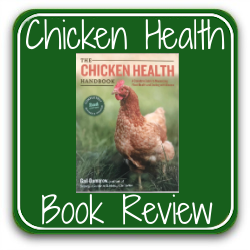- Home
- Plants for Chickens
- Parsley
Can chickens eat parsley?
Why has parsley become a favoured plant to maintain chickens' health, which type is best and how should it be fed?
Happily, there's an increase in the public's wish for the welfare of farmed animals - including chickens – to be less based in chemical "fixes" and "enhancers", and more concentrated on natural solutions.
That has led over a period of several years to two consequences:
- a European Union directive to reduce the use of chemicals in animal treatment
- a consequent growth in scientific, peer-reviewed research about using natural products as an alternative and complementary way to control avian illness and promote good health.
So – can chickens eat parsley?
Absolutely. Parsley has become one of those natural alternatives.
In this article, we'll look at what the benefits are, which type of parsley research shows is most effective, how to grow it in your own backyard (it's so easy!) and how to feed it to chickens.
Let's look at the basics first.
What is parsely?
Its botanical name is petroselinum crispum and it's a well known, very common herb used in cooking, particularly in Europe and Asia.
It's a biennial plant, but mostly grown as an annnual (that is, it needs replacing each year).
If allowed to grow for the second year it will produce flowers and seeds - more about that later.
There are more than thirty varieties of parsley. The two most well known are flat leaf, which is also called Italian (and sometimes French!) parsley, and curly leaf.
My friendly Chicken Digest group were recently given a list of eight herbs proven to be beneficial to chickens as a free, downloadable "cheat sheet". It's instantly accessible so that, if you want to grow some in your garden or on your windowsill, you can check which would help them most.
This list doesn't exist anywhere else.
For that and more helpful, instantly useable giveaways, why not sign up to my newsletter list?
Italian flat leaf vs curly: what does it look like, what's the difference, and can chickens eat both types of parsley?
Flat leafed parsley (Petroselinum crispum var. neapolitanum) as the name suggests, has large, flat leaves with three "lobes", lighter green when they're young, darker as the plant gets older.
Curly leafed parsley (Petroselinum crispum var. crispum) tends to be bright green and has "ruffled" leaves.
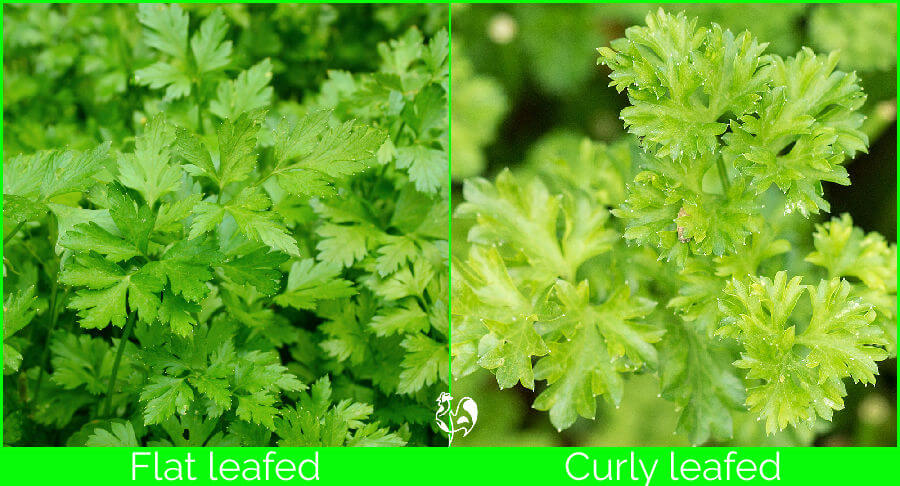
Flat leafed is generally used for cooking as it has a stronger taste; curly, being more showy, for garnish.
There's a chemical difference between the two, as well.
Flat-leafed parsley is scientifically proven to have a much higher concentration of essential oils in its leaves. And it's that which makes it the type used in research about enhancing chicken health.
So, if you're going to grow parsley for chickens, make sure it's the flat-leafed variety.
Can chickens eat parsley? The nutritional value.
All the following information refers to flat leafed parsley.
Vitamins. (Sources: 2, 3).
Vitamin 'C': Parsley, in particular the leaves but also the stem, contains a very high level - equivalent to four times that of a lemon(1, 2). Keeps the immune system healthy.
Vitamin 'A': critical for keeping a chicken's respiratory and digestive tracts in good condition.
Vitamin 'K': important for bone health, and for ensuring blood clotting.
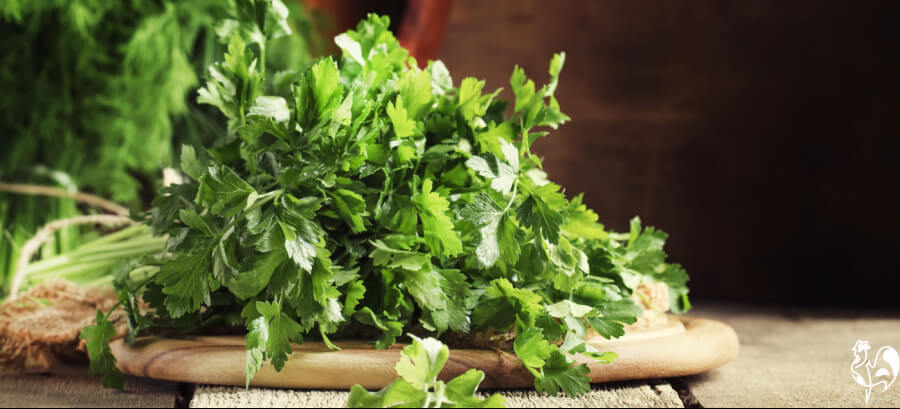
Take a look at more detailed information about vitamins, minerals and which to use.
Minerals and essential oils. (Sources: 2, 4).
Iron: Particularly important for laying hens to ensure egg quality and the healthy development of chicks(3).
Calcium: contains around 4%. Critical for bone health and eggshell quality.
Essential oils: contains between 2% and 8%, including linoleic, myristolic, and other fatty acids known to be important for healthy eggs, and for producing healthy chicks from laying hens.
What is parsley good for in humans?
There are all kinds of claims made for parsley in terms of human health. It's said to treat everything from bad breath and skin blemishes to fevers, cancer and even the plague.
The three major proven benefits of parsley for human health(4) concern...
- strengthening of the immune system and protection of cell development
- some antibiotic properties
- diuretic, helping body get rid of excess water.
Please note: parsley is not recommended for pregnant women.
Can chickens eat parsley? Its impact on chicken health.
The proven benefits of parsley for chickens include(5, 6):
- enhances cell development and so increases the strength of the immune system
- makes chickens better able to deal with stress
- maintains a high level of protein in the blood which helps repair damaged tissue and preserves a healthy body weight
- improves digestion; boosts the efficient absorption of food
- lowers LDL blood cholesterol.
Can chickens eat parsley? How to use it for optimum health benefits.
Very little parsley is needed to provide the necessary health benefits for chickens. Studies used parsley in two ways.
- Grinding the leaves to a powder and adding between 1 and 1.5 grammes per kilo of food (about a quarter ounce to 2lb).
- Grinding the seeds, and adding 3 grammes to one kilo of feed.
- Personally, I simply grow parsley plants in my chicken run. Some I place directly into the ground, other plants I keep in pots.
- I find that the chickens will regulate how much they eat.
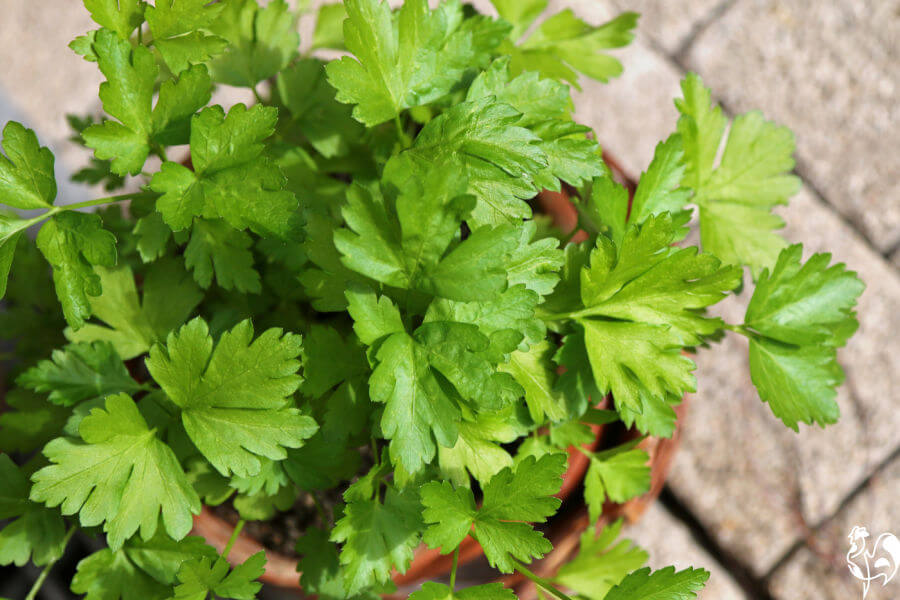 I grow parsley in a pot on the chicken run terrace.
I grow parsley in a pot on the chicken run terrace.How to grow parsley.
One of the easiest and low maintenance herbs, and with such high benefits for chickens, it's well worth growing your own.
Note that the plants bought from supermarkets generally do not do well as garden plants. It's best to buy from your local garden centre or nursery.
From seed.
- It's notoriously difficult to grow parsley from seed. Germination is very slow: it can take up to six weeks, although it can be hastened a little by soaking the seeds in warm water for 24 hours before sowing.
- The soil needs to be just right: between 10ºC and 29ºC (50º - 85º F), not too moist but not dry.
- Like other seedlings, they should be thinned out when they're large enough to handle. Keep them about 15 centimetres (about 6") apart.
- The seeds can also be sown in pots indoors, about six weeks before whatever the last frost date is in your area.
Growing small parsley plants in pots.
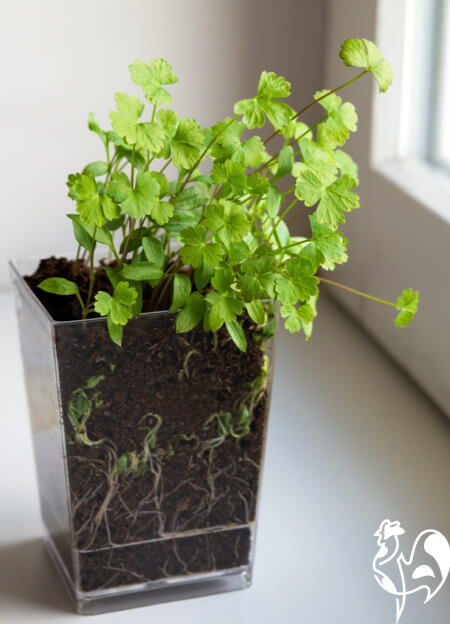
This is my favourite way of growing this herb. I let someone else do the hard part of germinating the seeds and growing the seedlings.
Grow small, starter plants in pots, taking care to keep them well watered, and they'll develop into the large, lush bushes which will produce parsley all summer.
Use a mix of garden soil and compost to help with water retention.
When the root system has grown into the small pots, move the plants into their final place. I use three small plants to one large (35 cm, 14") ceramic pot.
If you don't have space on an external terrace or in your chicken run, keep your parsley in pots on a sunny windowsill.
How to plant parsley outside.
- When the small plants' root system fills the small pots, they can be planted directly into your outside herb garden.
- They prefer the soil to be moist, but well drained, and they prefer sun or partial shade.
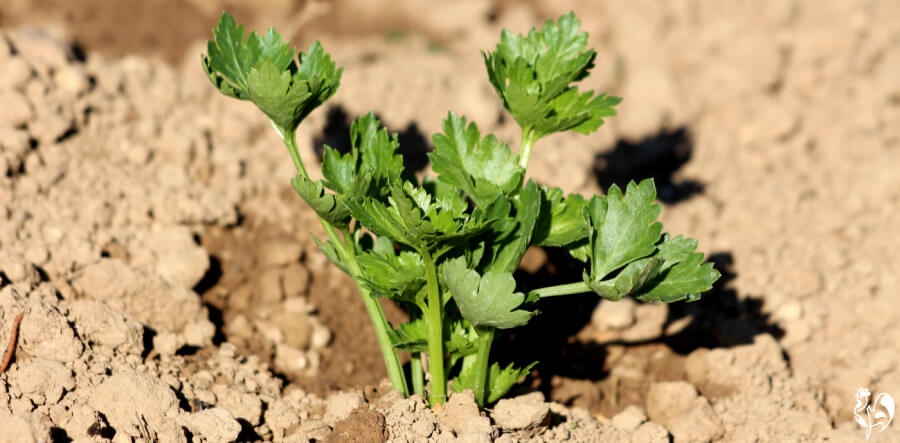 Parsley will grow well in garden soil.
Parsley will grow well in garden soil.How to care for parsley - wherever you plant it!
- Make sure the soil, whether it's inside or out, in a pot or in the garden, does not dry out. Parsley needs water, especially when the weather is hot and dry.
- It will benefit from an occasional feed of a general naturally based fertiliser - a seaweed based product is ideal.
- If you see leaves turning yellow, cut it back to encourage more growth.
- Should you want to collect seeds, stop cutting the parsley before summer's end and allow the plant to overwinter. It will flower the following year, when you can harvest the seeds.
- The flowers are also attractive to bees and hoverflies.
How and when to harvest parsley for chickens to eat.
- Parsley is best harvested when it's young. Older leaves can become tough and bitter.
- Harvest it as soon as the plant is established, by cutting stems from the base, on the outside of the plant.
- Having more than one plant means you can harvest from one and then move to another, leaving the first to produce new growth.
- To harvest seeds, keep the plants free from frost over the winter and wait until the second year when the flowers form. Collect the seeds when the heads have turned brown.
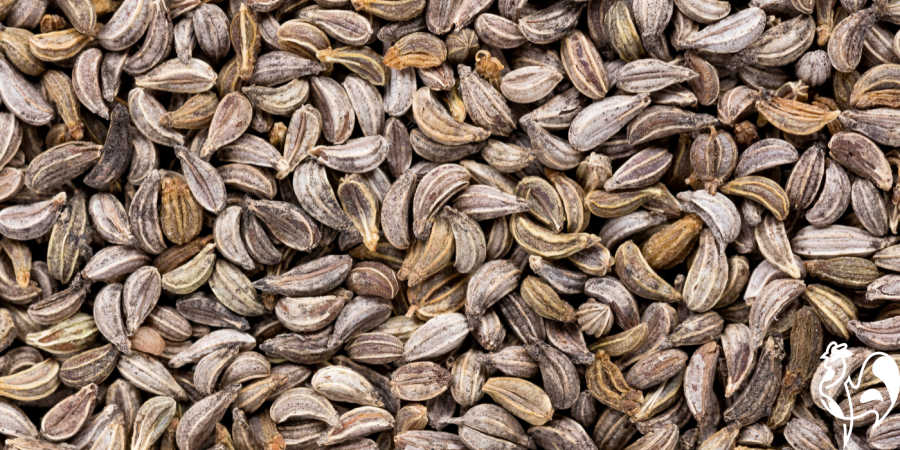 Parsley seeds - some studies used parsley seeds rather than the whole plant for chicken health.
Parsley seeds - some studies used parsley seeds rather than the whole plant for chicken health.How to dry and store fresh parsley.
- Use parsley fresh wherever possible. It's a good idea, though, to store it when it's plentiful in the summer, for continued use in the winter when the plants have stopped producing.
- To dry, simply hang a bunch in a warm, well ventilated room. Make sure air can circulate around it, or there's a danger it will develop mould.
- When it's dried, crush the leaves with a pestle and mortar and store it in an airtight jar.
- You can also freeze it by chopping the leaves, adding them to an ice cube tray and topping up with water or an extra virgin olive oil. Freeze and keep in freezer bags until you're ready to use.
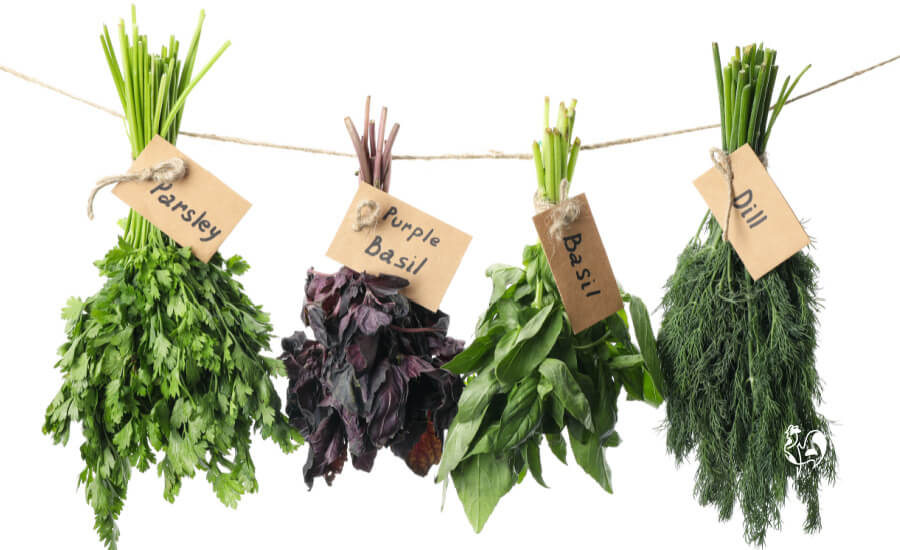

Other pages you may enjoy.
- Home
- Plants for Chickens
- Parsley

Sources.
A lot of "facts" you'll find on the internet are often people's individual views, based on inaccurate information repeated from poor quality sources.
The information I provide in this article and others is based not just on my own experience, but on evidenced facts from scientific, peer-reviewed research and books from highly respected and experienced poultry keepers such as Gail Damerow.
Some of the trusted sources I have used in this article are these.
1. Kumar, V: Petroselinum crispum. Pub. Encyclopedia of Food and Health, 2016.
2. Al-Quaisy, G. A et al: Effect of Additional Different Level of Parsley Leaves (petroselinum sativum) Powder to the Ration on Some Blood Serum Biochemical Traits of Broiler Ross. Published Journal of Natural Sciences Research, 2016.
3. Taschetto, D, et al: Iron requirements of broiler hens. Pub. Journal of Poultry Science, 2017.
4. Nielson et al: Effect of parsley intake on urinary apigenin excretion, blood antioxidant enzymes and biomarkers for oxidative stress in human subjects. Pub. British Journal of Nutrition, 1999.
5. Abbas, R. J: Effect of using fenugreek, parsley and sweet basil seeds as feed additives on the performance of broiler chickens. Pub. International Journal of Poultry Science, 2010.
6. Osman, M., Amber, K.H. and Mahmoud, M.A: Response of broiler chicks performance to partial dietary inclusion of radish, rocket and parsley cakes. Pub. Journal of Egyptian Poultry Science, 2004.
7. BBC Gardners' World: How to grow parsley. Pub. 2019.
